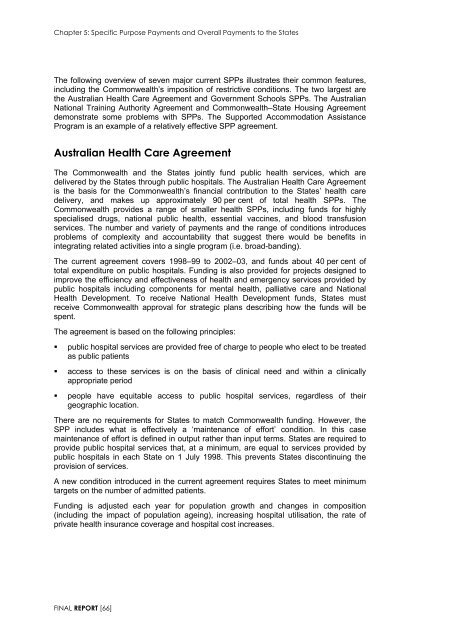Garnaut Fitzgerald Review of Commonwealth-State Funding
Garnaut Fitzgerald Review of Commonwealth-State Funding
Garnaut Fitzgerald Review of Commonwealth-State Funding
Create successful ePaper yourself
Turn your PDF publications into a flip-book with our unique Google optimized e-Paper software.
Chapter 5: Specific Purpose Payments and Overall Payments to the <strong>State</strong>s<br />
The following overview <strong>of</strong> seven major current SPPs illustrates their common features,<br />
including the <strong>Commonwealth</strong>’s imposition <strong>of</strong> restrictive conditions. The two largest are<br />
the Australian Health Care Agreement and Government Schools SPPs. The Australian<br />
National Training Authority Agreement and <strong>Commonwealth</strong>–<strong>State</strong> Housing Agreement<br />
demonstrate some problems with SPPs. The Supported Accommodation Assistance<br />
Program is an example <strong>of</strong> a relatively effective SPP agreement.<br />
Australian Health Care Agreement<br />
The <strong>Commonwealth</strong> and the <strong>State</strong>s jointly fund public health services, which are<br />
delivered by the <strong>State</strong>s through public hospitals. The Australian Health Care Agreement<br />
is the basis for the <strong>Commonwealth</strong>’s financial contribution to the <strong>State</strong>s’ health care<br />
delivery, and makes up approximately 90 per cent <strong>of</strong> total health SPPs. The<br />
<strong>Commonwealth</strong> provides a range <strong>of</strong> smaller health SPPs, including funds for highly<br />
specialised drugs, national public health, essential vaccines, and blood transfusion<br />
services. The number and variety <strong>of</strong> payments and the range <strong>of</strong> conditions introduces<br />
problems <strong>of</strong> complexity and accountability that suggest there would be benefits in<br />
integrating related activities into a single program (i.e. broad-banding).<br />
The current agreement covers 1998–99 to 2002–03, and funds about 40 per cent <strong>of</strong><br />
total expenditure on public hospitals. <strong>Funding</strong> is also provided for projects designed to<br />
improve the efficiency and effectiveness <strong>of</strong> health and emergency services provided by<br />
public hospitals including components for mental health, palliative care and National<br />
Health Development. To receive National Health Development funds, <strong>State</strong>s must<br />
receive <strong>Commonwealth</strong> approval for strategic plans describing how the funds will be<br />
spent.<br />
The agreement is based on the following principles:<br />
• public hospital services are provided free <strong>of</strong> charge to people who elect to be treated<br />
as public patients<br />
• access to these services is on the basis <strong>of</strong> clinical need and within a clinically<br />
appropriate period<br />
• people have equitable access to public hospital services, regardless <strong>of</strong> their<br />
geographic location.<br />
There are no requirements for <strong>State</strong>s to match <strong>Commonwealth</strong> funding. However, the<br />
SPP includes what is effectively a ‘maintenance <strong>of</strong> effort’ condition. In this case<br />
maintenance <strong>of</strong> effort is defined in output rather than input terms. <strong>State</strong>s are required to<br />
provide public hospital services that, at a minimum, are equal to services provided by<br />
public hospitals in each <strong>State</strong> on 1 July 1998. This prevents <strong>State</strong>s discontinuing the<br />
provision <strong>of</strong> services.<br />
A new condition introduced in the current agreement requires <strong>State</strong>s to meet minimum<br />
targets on the number <strong>of</strong> admitted patients.<br />
<strong>Funding</strong> is adjusted each year for population growth and changes in composition<br />
(including the impact <strong>of</strong> population ageing), increasing hospital utilisation, the rate <strong>of</strong><br />
private health insurance coverage and hospital cost increases.<br />
FINAL REPORT [66]

















